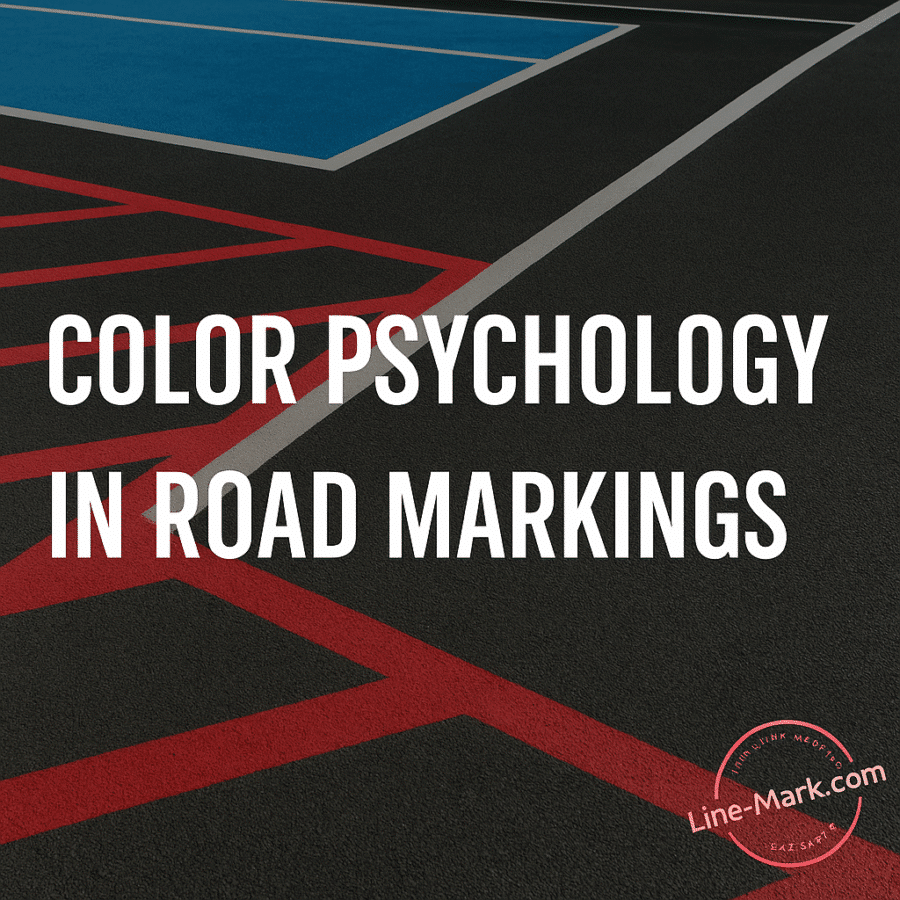Colour psychology in line marking
Excerpt: The colours used in line marking aren’t random. Each hue communicates meaning, influences behaviour, and can directly affect safety. Here’s how colour psychology in line marking helps create safer, more organised spaces — and how choosing the right palette for your site can prevent confusion and accidents.

Colour Psychology in Line Marking: How Colour Choice Impacts Safety and Behaviour
When you step into a warehouse, car park, or production area, the first thing you notice — even subconsciously — is the colour of the lines. Colour psychology in line marking plays a powerful role in how people move, react, and stay safe. Each colour sets expectations and communicates rules without needing a single word of text.
At Line-Mark.com, we help businesses design layouts that don’t just look professional — they influence behaviour. Choosing the right colours for line marking safety ensures your site communicates clearly, even under pressure or in noisy, fast-moving environments.
Need help planning your layout? Book a free site consultation and our team will recommend the best colour system for your site’s safety and compliance needs.
Why Colour Matters in Line Marking Safety
Colours trigger instinctive responses. Red means stop. Green means go. Yellow warns of caution. These associations are deeply ingrained in human psychology — and when used correctly in line marking, they dramatically reduce hesitation and human error.
- Instant recognition: Workers can identify zones and hazards without reading signage.
- Universal language: Colour systems transcend language barriers across international teams.
- Faster decision-making: Visual cues reduce the mental effort needed to stay safe.
- Behavioural influence: Correct use of colour subconsciously encourages compliance and order.
In safety-critical environments, the wrong colour choice — or a lack of consistency — can cause confusion that leads to incidents. That’s why colour psychology in line marking is more than just design; it’s risk management.
Want to make your site safer? Our experts can audit your current layout and create a compliant, easy-to-understand colour plan. Request a free colour audit today.
The Meaning of Common Line Marking Colours
While colour standards can vary by sector, there are widely recognised conventions across industry, logistics, and manufacturing. Here’s what each shade typically means — and why it matters:
| Colour | Meaning / Use |
|---|---|
| Yellow | Warning or caution areas. Common for traffic lanes, forklift routes, or pedestrian crossings. |
| White | General traffic control, route lines, or demarcation in neutral zones. |
| Red | Danger zones or restricted areas (e.g. fire exits, emergency routes, electrical hazards). |
| Green | Safe areas, first aid zones, or emergency escape routes. |
| Blue | Mandatory routes or information markings, often used in compliance-based industries. |
| Black | Used for contrast or to define boundaries in light-coloured environments. |
| Orange | Temporary markings for construction or maintenance works. |
By maintaining colour consistency across your site, you help everyone — from full-time staff to visitors and contractors — instantly understand where they should (and shouldn’t) be.
How Colour Psychology Enhances Behaviour
Colour doesn’t just signal safety; it shapes how people behave. Studies show that bright, contrasting colours increase alertness, while softer tones can calm high-stress areas. For example:
- Yellow and black striping grabs attention and signals potential danger.
- Green walkways subconsciously feel safer, guiding pedestrians naturally.
- Blue zones promote order and compliance in controlled areas.
- Consistent colour coding reinforces positive habits and reduces mental fatigue.
Over time, your workforce learns to trust these visual cues — making safety second nature rather than an instruction that has to be repeated.
Thinking of updating your site layout? Contact Line-Mark.com to design a custom colour system that enhances visibility, reduces risk, and aligns with UK safety standards.
Colour and Compliance Standards
In the UK, line marking colours are guided by Health and Safety Executive (HSE) recommendations and British Standards such as BS 1710 and BS 381C. Following these ensures compliance with safety legislation and creates consistency across sites.
Our team applies these standards while tailoring layouts to each site’s unique needs. We consider visibility, lighting conditions, flooring type, and traffic flow to select colours and materials that last.
Not sure if your site meets current standards? Book a free compliance check with our team. We’ll assess your layout and provide a clear action plan for safer, more compliant markings.
When to Repaint or Refresh Colours
Over time, footfall, vehicles, and cleaning chemicals can dull or fade markings. This not only reduces visual contrast but weakens the psychological impact of colour. For most industrial sites, a refresh every 12–18 months maintains both appearance and effectiveness.
When colours fade, safety communication fades with them — and so does compliance. Regular inspections ensure your visual safety language stays loud and clear.
Turn Your Site Into a Visual Safety System
Colour psychology in line marking is a subtle but powerful safety tool. It reduces cognitive load, improves reaction times, and communicates instantly — even when noise, stress, or time pressure make verbal instruction impossible.
Ready to create a safer, smarter site? Get in touch with Line-Mark.com today for your free design consultation or site visit. Let’s make your layout clear, compliant, and safe for everyone.
Read next: How Clear Road Line Markings Reduce Accidents and Save Lives

